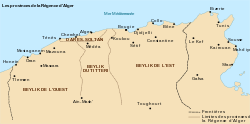User:Whatever748/Beylik of the West
Beylik of the West بايلك الغرب (bâylik al-garb) | |||||||||
|---|---|---|---|---|---|---|---|---|---|
 The Beyliks of Algiers. Beylik of the west is on the left side. | |||||||||
| Capital | Mazouna (1563-1701) Mascara (1701-1792) Oran (1792-1831) | ||||||||
| Official languages | Arabic Berber languages Ottoman Turkish | ||||||||
| Recognised national languages | Algerian Arabic Judeo-Arabic dialects | ||||||||
| Religion | Maliki Sunni Islam (official) minorities: Shia Islam Judaism Catholicism | ||||||||
| Demonym(s) | Oranese, Wahrani | ||||||||
| Governorate, with occasional revolts | |||||||||
| History | |||||||||
• Established | 1563 | ||||||||
| 1831 | |||||||||
| |||||||||
| Today part of | Algeria | ||||||||
The Beylik of the West (in arabic : bâylik al-garb) was one of three Beyliks (governorates) of the Regency of Algiers, with the other two being the Beylik of Titteri and the Beylik of Constantine. It was established in 1563, and it was ended during the French conquest.
Geography
[edit]The Beylik of the West was the largest one out of the Beyliks of Algiers[1], it largely corresponded to Oranie[2]. It stretched from Morocco to the west, to Algiers in the east, the Mediterranean Sea to the North, and the Sahara to the south. It's capital was Mazouna, then Mascara and the last one was Oran. The exact borders of the Beylik constantly flunctuated thanks to conflicts with Saharan tribes, and Morocco. Oran and Mers el-Kébir were under Spanish control until 1792, when it was recaptured (with the exception of 1708 to 1732, when the cities were briefly recaptured)[3].
Tlemcen was the most important city followd by Mostaganem and Mascara[4]. Other important towns included Mazouna, Nedroma, Kalaa, Miliana and Oran[5] after it's reconquest.
History
[edit]
After returning from Mostaganem in 1563, after a failed campaign to reconquer Oran and Mers el-Kébir, Hassan Pacha decided to leave a local governorate capable of reinforcing the authority of Algiers, and to fight against the Spanish[6].
Hassan Pasha designated Bou Khedidja as governor of the province. He re-organized the region, appointing the caïds in the main towns and chose Mazouna in the interior of the country as his residence, he constituted a makhzen of allied tribes, by granting them privileges, and forcing the rebellious tribes to obey[6]. His successor, Souag of Mazouna continued his work. He fought against an uprising led by the marabout Mohamed Ben Ali. The beys Sayah and Saad established their authority over the Berber tribes of Dahra.
Mazouna remained the capital of the Beylik until the end of the 17th century. The bey Mustapha Bouchlaghem, a kouloughli (mixed Algerian-Turkish), transfered the capital to Mascara, because it was in a more central position. He took Oran from the Spaniards in 1708, which then became his residence, but in 1732 the Spaniard retook the city and Bouchelaghem had to take refuge in Mostaganem[7]. In 1748, the Kouloughlis of Tlemcen revolted, albeit the revolt was crushed. In 1754, a new revolt started in the town led by caïd Radjem[8].
In 1779, Mohamed el Kebir, another kouloughli was appointed as Bey of Oran. He reorganized the province and restored order. He recaptured Oran and Mers-el-kébir in 1792, which is the origin of the « el Kebir »[7] part of his name (which also means the great). Oran became the capital of the province[9]. After his death in 1799, his son Othman was designated as Bey. The province was met with new difficulties, mainly revolts instigated by marabouts and the religious brotherhoods of Tidjaniya and Derqaoua[10].
After the Fall of Algiers, and the expulsion of dey Hussein, the forces of the three Beyliks of Constantine, Oran and Titteri didn't regroup against the forces of the invader. French troops occupied Oran on 1 January 1831. The submission of Bey Hassan caused the population to flee the town. He was replaced by Bey Kheireddine who was sent from Tunis by the French administration.
Beys of Western Beylik
[edit]List of Beys of the Western Beylik
References
[edit]- ^ Kaddache 1992.
- ^ Marc Côte, Marc (1996). Guide d'Algérie. Média-Plus. p. 207. ISBN 9961-922-00-X.
{{cite book}}: More than one of|pages=and|page=specified (help); Unknown parameter|ignore-isbn-error=ignored (|isbn=suggested) (help) - ^ Lakjaa, Abdelkader (2008-10-01). "Oran, une ville algérienne reconquise ; Un centre historique en mutation". L'Année du Maghreb (in French) (IV): 441–456. doi:10.4000/anneemaghreb.472. ISSN 1952-8108. Retrieved 2017-12-22.
{{cite journal}}: no-break space character in|title=at position 38 (help) - ^ Kamel Kateb (2001). Européens, "indigènes" et juifs en Algérie (1830-1962). INED. p. 69.
- ^ Kaddache 1992.
- ^ a b Kaddache 1992.
- ^ a b Kaddache 1992.
- ^ Kaddache 1992.
- ^ Kaddache 1992.
- ^ Kaddache 1992.
Related articles
[edit][[Category:Ottoman Algeria]] [[Category:WikiProject Algeria articles]] [[Category:WikiProject Africa articles]] [[Category:Algeria]] [[Category:Oran]] [[Category:Mascara, Algeria]] [[Category:States and territories disestablished in 1831]]
